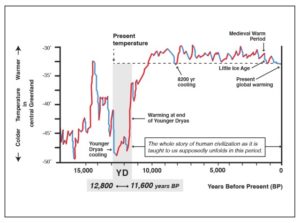by Poppaloff, January 10, 2020 in Electroverse
If the historical data is anything to go by, magnetic reversals/excursions often lead to large-level extinction events. Mounting evidence also suggests that our sun micro-novas every 12,000 years, or thereabouts, and that these two events are linked. Earth’s temperature has been on a downward trend since the sharp-warming that followed the end of the Younger Dryas, indicating that this coming Grand Solar Minimum could steer us back into a major glaciation period, and another extinction event.
In their 2014 paper, a group of scientists which included UC Santa Barbara’s James Kennett, posited that a comet collision with Earth played a major role in the extinction. Their hypothesis suggests that a cosmic-impact-event caused the Younger Dryas period of global cooling close to 12,800 years ago. This cosmic impact resulted in abrupt environmental stress and degradation that contributed to the extinction of most large animal species then inhabiting the Americas. According to Kennett, the catastrophic impact and the subsequent climate change also led to the disappearance of the prehistoric Clovis culture, known for its big game hunting, and to human population decline.
…

…
by F. Muschitiello et al., March 20, 2019 in Nature
Abstract
Constraining the response time of the climate system to changes in North Atlantic Deep Water (NADW) formation is fundamental to improving climate and Atlantic Meridional Overturning Circulation predictability. Here we report a new synchronization of terrestrial, marine, and ice-core records, which allows the first quantitative determination of the response time of North Atlantic climate to changes in high-latitude NADW formation rate during the last deglaciation. Using a continuous record of deep water ventilation from the Nordic Seas, we identify a ∼400-year lead of changes in high-latitude NADW formation ahead of abrupt climate changes recorded in Greenland ice cores at the onset and end of the Younger Dryas stadial, which likely occurred in response to gradual changes in temperature- and wind-driven freshwater transport. We suggest that variations in Nordic Seas deep-water circulation are precursors to abrupt climate changes and that future model studies should address this phasing.
…
by James Kennett et al., March 13, 2019 in CO2Coalition
When UC Santa Barbara geology professor emeritus James Kennett and colleagues set out years ago to examine signs of a major cosmic impact that occurred toward the end of the Pleistocene epoch, little did they know just how far-reaching the projected climatic effect would be.
“It’s much more extreme than I ever thought when I started this work,” Kennett noted. “The more work that has been done, the more extreme it seems.”
He’s talking about the Younger Dryas Impact Hypothesis, which postulates that a fragmented comet slammed into the Earth close to 12,800 years ago, causing rapid climatic changes, megafaunal extinctions, sudden human population decrease and cultural shifts and widespread wildfires (biomass burning). The hypothesis suggests a possible triggering mechanism for the abrupt changes in climate at that time, in particular a rapid cooling in the Northern Hemisphere, called the Younger Dryas, amid a general global trend of natural warming and ice sheet melting evidenced by changes in the fossil and sediment record.
…

La géologie, une science plus que passionnante … et diverse


